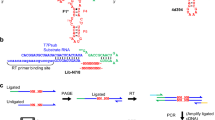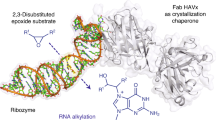Abstract
RNA enzymes are postulated to have catalysed all chemical reactions in the earliest living cells. This idea is now investigated in a search for alkyl transferases from a pool of random sequence RNAs. Selection for self-biotinylation yields a transfer RNA-like ribozyme that efficiently catalyses carbon–nitrogen bond formation. Ribozymes can thus promote reactions other than those involving the RNA sugar–phosphate backbone, suggesting that RNA may be capable of a broad range of catalytic activities.
This is a preview of subscription content, access via your institution
Access options
Subscribe to this journal
Receive 51 print issues and online access
$199.00 per year
only $3.90 per issue
Buy this article
- Purchase on Springer Link
- Instant access to full article PDF
Prices may be subject to local taxes which are calculated during checkout
Similar content being viewed by others
References
Joyce, G. F. Nature 338, 217–224 (1989).
Benner, S. A., Ellington, A. D. & Tauer, A. Proc. natn. Acad. Sci. U.S.A. 86, 7054–7058 (1989).
Wilson, C. & Szostak, J. W. Curr. Opin. struct. Biol. 2, 749–756 (1992).
Ellington, A. D. & Szostak, J. W. Nature 346, 818–822 (1990).
Famulok, M. & Szostak, J. W. J. Am. chem. Soc. 114, 3990–3991 (1992).
Sassanfar, M. & & Szostak, J. W. Nature 364, 550–553 (1993).
Connell, G. J., Illangesekare, M. & Yarus, M. Biochemistry 32, 5497–5502 (1993).
Lorsch, J. R. & Szostak, J. W. Biochemistry 33, 973–982 (1994).
Jenison, R. D., Gill, S. C., Pardi, A. & Polisky, B. Science 263, 1425–1429 (1994).
Famulok, M. J. Am. chem. Soc. 116, 1698–1706 (1994).
Bartel, D. P. & Szostak, J. W. Science 261, 1411–1418 (1993).
Lorsch, J. R. & Szostak, J. W. Nature 371, 31–36 (1994).
Prudent, J. R., Uno, T. & Schultz, P. G. Science 264, 1924–1927 (1994).
Green, N. M. Adv. Protein Chem. 29, 85–133 (1975).
Al-hakim, A. H. Biochem. J. 251, 935–938 (1988).
Peattie, D. A. Proc. natn. Acad. Sci. U.S.A. 76, 1760–1764 (1979).
Tramontano, A., Ammann, A. A. & Lerner, R. A. J. Am. chem. Soc. 110, 2282–2283 (1988).
Janda, K. D., Weinhouse, M. I., Schloeder, D. M., Lerner, R. A., & Benkovic, S. J. J. Am. chem. Soc. 112, 1274–1275 (1990).
Fersht, A. Enzyme Structure and Mechanism, 2nd edn 57–59 (Freeman, New York, 1985).
Author information
Authors and Affiliations
Rights and permissions
About this article
Cite this article
Wilson, C., Szostak, J. In vitro evolution of a self-alkylatlng ribozyme. Nature 374, 777–782 (1995). https://doi.org/10.1038/374777a0
Received:
Accepted:
Issue Date:
DOI: https://doi.org/10.1038/374777a0
This article is cited by
-
A SAM analogue-utilizing ribozyme for site-specific RNA alkylation in living cells
Nature Chemistry (2023)
-
Structural basis for substrate binding and catalysis by a self-alkylating ribozyme
Nature Chemical Biology (2022)
-
Structure and mechanism of a methyltransferase ribozyme
Nature Chemical Biology (2022)
-
Total RNA Synthesis and its Covalent Labeling Innovation
Topics in Current Chemistry (2022)
-
The essence of life revisited: how theories can shed light on it
Theory in Biosciences (2022)
Comments
By submitting a comment you agree to abide by our Terms and Community Guidelines. If you find something abusive or that does not comply with our terms or guidelines please flag it as inappropriate.



